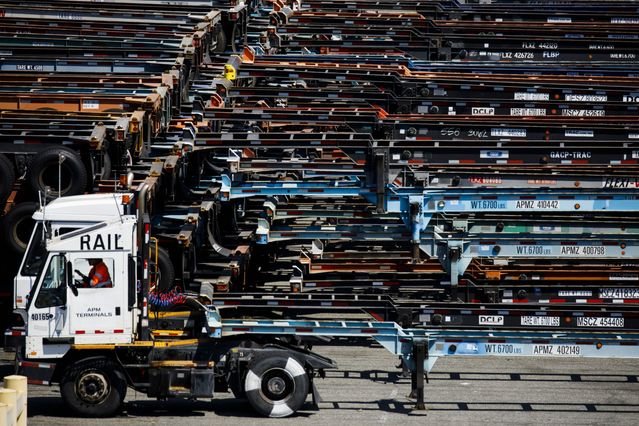The world is in the middle of a global supply chain crisis. China’s overcapacity has driven down prices and forced other countries to curb production or go out of business entirely, which means companies are losing profits at an alarming rate. What this means for consumers is higher costs across the board, but it also spells disaster for underdeveloped nations who depend on exporting raw materials to developed ones.
Supply chain problems due to covid-19 are one of the leading causes of supply chain disruptions. A simple piece of steel and wheels is holding up the global supply chain.
Transportation executives tasked with alleviating the supply-chain congestion plaguing American importers believe the ability to break bottlenecks is primarily dependent on a basic piece of steel and wheels that has long been an afterthought in global transportation.
Officials said that trucking trailers, also known as chassis, that are used to ferry containers from dockside terminals have become more difficult to come by at the ports of Los Angeles and Long Beach, Calif., as a flood of imports has overwhelmed the facilities and clogged up equipment needed to keep goods moving.
Executives familiar with the ports’ operations say that resolving the coast’s gridlock, which includes a backup of more than 70 container ships anchored offshore and waiting for berth space, will be impossible without resolving equipment issues, such as the chassis shortage, that have stymied operations.
According to Matt Schrap, chief executive of the Harbor Trucking Association, which represents port truckers in Southern California, “the chassis are the biggest issue” in problems that extend from the docks at the neighboring Los Angeles and Long Beach ports to warehouses deeper into California and intermodal rail yards in the Midwest.
At a cargo facility at the Port of Los Angeles, truck chassis are piled.
Patrick T. Fallon/Bloomberg News photo
According to Mr. Schrap and other authorities, the reason container ships are backed up outside the country’s largest container seaport complex is because dockworkers can’t unload ships fast because terminals are packed with boxes that trucks can’t pick up because they can’t find a chassis.
According to DCLI, a prominent chassis vendor, there are around 115,000 chassis at the ports of Los Angeles and Long Beach. A bit more than half of the frames are owned or rented by individuals. The remaining 57,000 chassis are available for leasing from a common pool provided by DCLI and two other companies.
Thousands of containers pass through the ports every day, and there are usually enough trailers to carry them. However, executives claim that the unrelenting high volume of imports, which began in the middle of 2020, combined with labor shortages at warehouses and other cargo-handling facilities, has resulted in the frames being away from the ports for long periods of time, limiting operators’ ability to turn around the equipment and transport new boxes.
Pooled chassis at Southern California ports were detained outside the port for more than nine days on average in September, according to Mike O’Malley, a DCLI spokesperson. This is more than twice the time they were occupied before the coronavirus epidemic.
The frames are part of a well-executed plan. A trucker picks up the chassis near the ports, drives to a terminal to have a container loaded, transports it to a warehouse 50 miles away, and then repeats the process.
Because many warehouses are now overburdened, causing delays in emptying the container, the trucker often keeps the box atop the chassis at a receiving facility for days longer than normal.
Operators claim that delays at destination locations have thrown the system off balance.
Subscribe to our newsletter
Report on Logistics
Top news and in-depth analysis on everything from supply chain to transportation and technology in the field of logistics.
Today, too frequently, said Weston LaBar, chief strategy officer of Cargomatic Inc., a freight network that connects drivers and shippers, chassis “are being exploited as a storage device.”
Ocean carriers have also imposed limits on when empty containers may be returned, further aggravating the situation. According to a study conducted by the Harbor Trucking Association last week, 6,592 chassis were jammed under empty containers by 46 trucking companies.
“It’s a vicious circle,” said Lisa Wan, head of operations at RoadEx America, a trucking firm based in California. “Where can I obtain a bare chassis to pick up the import container if I can’t bring in an empty to reuse my chassis?”
According to haulage and chassis executives, a decrease in the availability of new frames is compounding the shortfall. The US International Trade Commission levied countervailing and antidumping penalties on Chinese chassis companies that provided the bulk of frames to the US in May, totalling more than 200 percent.
The Port of Los Angeles in California is failing to keep up with the influx of cargo containers arriving at its ports, resulting in one of the world’s most serious supply-chain bottlenecks. The scale of the issue and the difficulties of the procedure are shown in this rare aerial footage.
The ITC moves, according to a group of US chassis manufacturers that argued in support of them, haven’t led to supply-chain bottlenecks. Companies like Cheetah Chassis, located in Berwick, Pa., are striving to scale up manufacturing, according to Frank Katz, CEO of one of the major domestic manufacturers.
The actual problem, according to Mr. Katz, is that the spike in imports has overburdened the local supply system. “It wouldn’t make any difference if we could quadruple production,” Mr. Katz added.
Domestic manufacturers are hundreds of units short of his company’s orders for new equipment, according to Doug Hoehn, executive vice president of Milestone Chassis Co., a leasing business located in Lombard, Ill. Milestone operates a fleet of 20,000 chassis throughout North America, notably in Southern California, that must be replenished on a regular basis due to wear and tear.
Mr. Hoehn remarked, “If you came to lease a chassis today, my reaction would be, ‘Here’s a piece of paper, sign it, and I can get you a chassis in the third quarter of next year.”
Paul Berger can be reached at [email protected].
Dow Jones & Company, Inc. All Rights Reserved. Copyright 2021 Dow Jones & Company, Inc. 87990cbe856818d5eddac44c7b1cdeb8
The “why are there supply chain issues” is a piece of steel and wheels that hold up the global supply chain. This simple piece of metal has become the key to making sure food, water, and other necessities can be delivered to people around the world.
Related Tags
- companies with supply chain issues 2021
- global supply chain issues 2021
- current supply chain issues
- food supply chain issues 2021
- when will supply chain be back to normal


